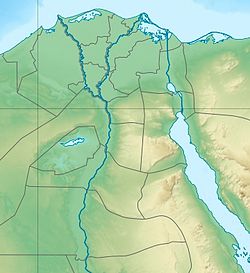
Back Aboesir Afrikaans أبو صير (البدرشين) Arabic ابو صير ARZ Abousir Breton Abusir al-Melek Catalan Ahrāmāt Abū Şīr CEB Abúsír Czech Abusir German Αμπουσίρ Greek Abusir Esperanto
 | |
| Location | Egypt |
|---|---|
| Region | Giza Governorate |
| Coordinates | 29°54′N 31°12′E / 29.9°N 31.2°E |
| Criteria | Cultural: (i)(iii)(vi) |
| Designated | 1979 (3rd session) |
| Part of | Memphis and its Necropolis – the Pyramid Fields from Giza to Dahshur |
| Reference no. | 86-002 |
| |||||
| Busiri in hieroglyphs | |||||
|---|---|---|---|---|---|
Abusir (Arabic: ابو صير Egyptian Arabic pronunciation: [æbuˈsˤiːɾ]; Egyptian pr wsjr; Coptic: ⲃⲟⲩⲥⲓⲣⲓ busiri, "the resting place of Osiris"; Ancient Greek: Βούσιρις) is the name given to an ancient Egyptian archaeological pyramid complex comprising the ruins of 4 kings' pyramids dating to the Old Kingdom period, and is part of the Pyramid Fields of the Memphis and its Necropolis UNESCO World Heritage Site.[1]
The pyramid complex is named after the neighbouring village of Abusir, in the markaz (county) of Badrashin, Giza.[2] The Abusir pyramid complex is located on the Western Desert plateau at the edge of the cultivated plain, with the Giza Pyramids to its north, and Saqqara to its south, and served as one of the main elite cemeteries for the ancient Egyptian capital city of Memphis. Several other villages in northern and southern Egypt are named Abusir or Busiri.
The locality of Abusir took its turn as the focus of the prestigious western burial rites operating out of the then-capital of Memphis during the Old Kingdom 5th Dynasty. As an elite cemetery, neighbouring Giza had by then "filled up" with the massive pyramids and other monuments of the 4th Dynasty, leading the 5th Dynasty pharaohs to seek sites elsewhere for their own funerary monuments.
Abusir was the origin of the largest find of Old Kingdom papyri to date — the Abusir Papyri. In the late nineteenth century, a number of Western museums acquired collections of fragmentary papyri from the administrative (temple) records of one Abusir funerary cult, that of king Neferirkare Kakai. This discovery was supplemented in the late twentieth century when excavations by a Czech expedition to the site revealed papyri from two other cult complexes, that of the pharaoh Neferefre (also read Raneferef) and for the king's mother Khentkaus II.
The Czech Institute of Egyptology of the Faculty of Arts, Charles University in Prague has been conducting excavations at Abusir since 1960, beginning with the mastaba of Ptahshepses, directed by Zbyněk Žába. The concession was extended since 1976 with the southern part of the royal necropolis, directed by Miroslav Verner. Since 1991, the institute excavates also at the site of Abusir South. The excavations are presently directed by Miroslav Bárta.
There are considerable catacombs near the ancient town of Busiris, as stated in (Pliny xxxvi. 12. s. 16). To the south of Busiris one great cemetery appears to have stretched over the plain. The Heptanomite Busiris was in fact a hamlet standing at one extremity of the necropolis of Memphis.
- ^ "Memphis and its Necropolis – the Pyramid Fields from Giza to Dahshur". UNESCO World Heritage Centre. United Nations Educational, Scientific, and Cultural Organization. Retrieved 7 September 2021.
- ^ "Markaz al-Badrashin Map". www.giza.gov.eg. Retrieved 2023-01-22.
© MMXXIII Rich X Search. We shall prevail. All rights reserved. Rich X Search
